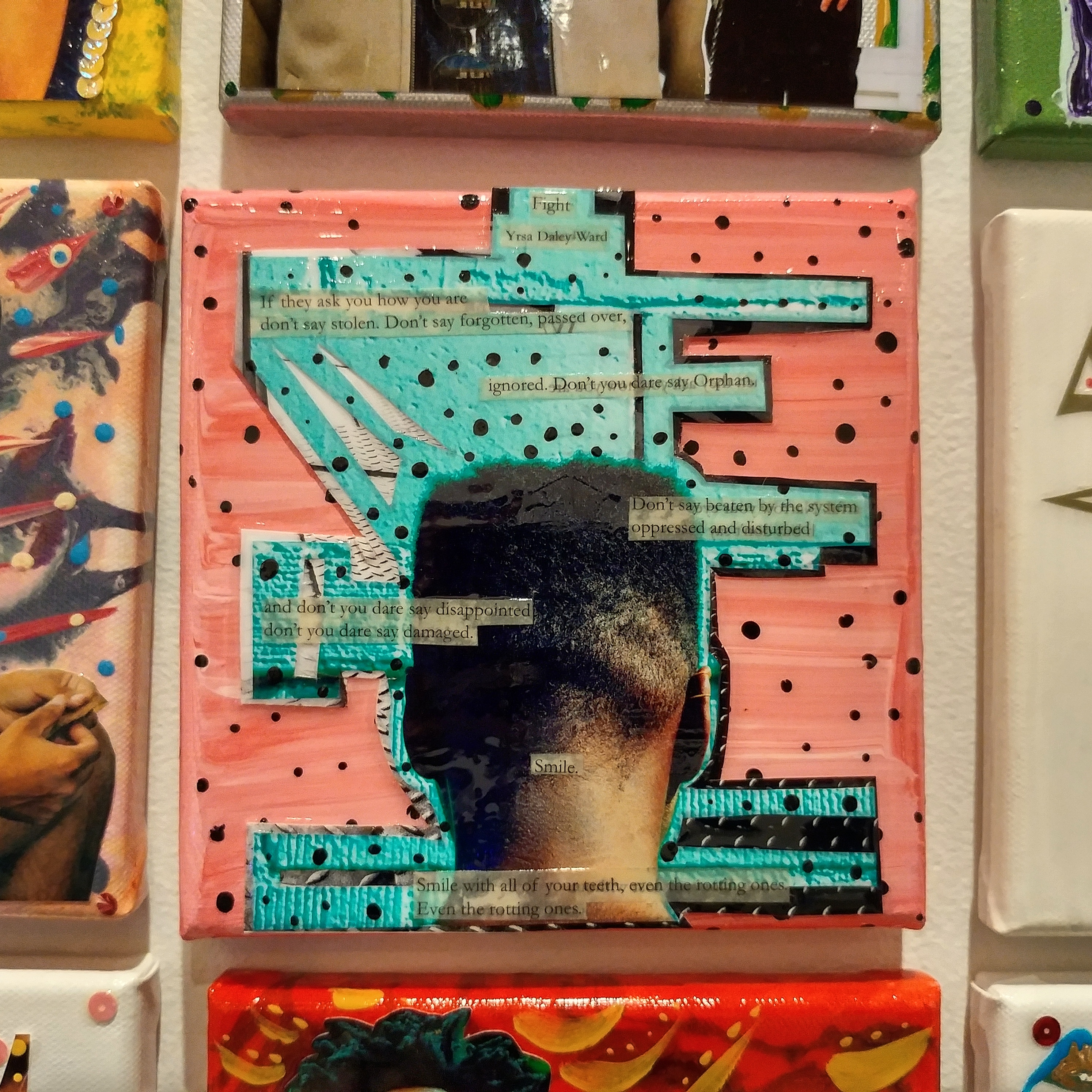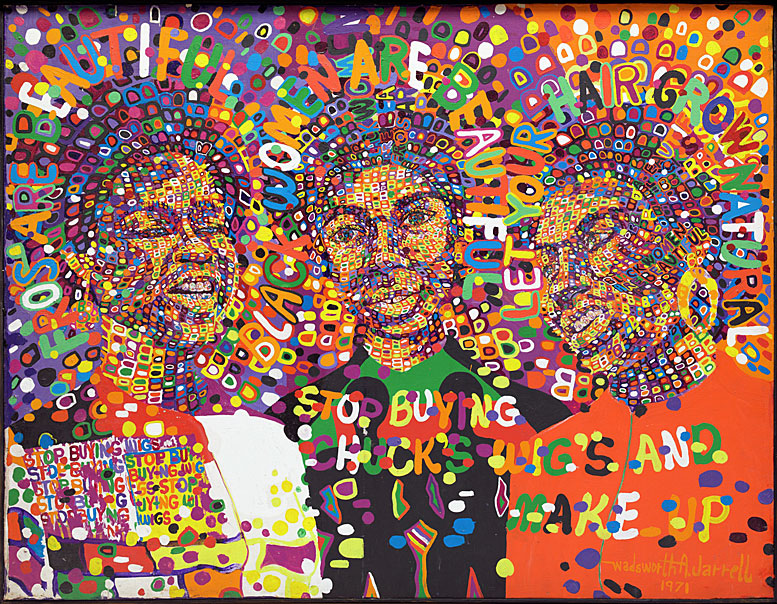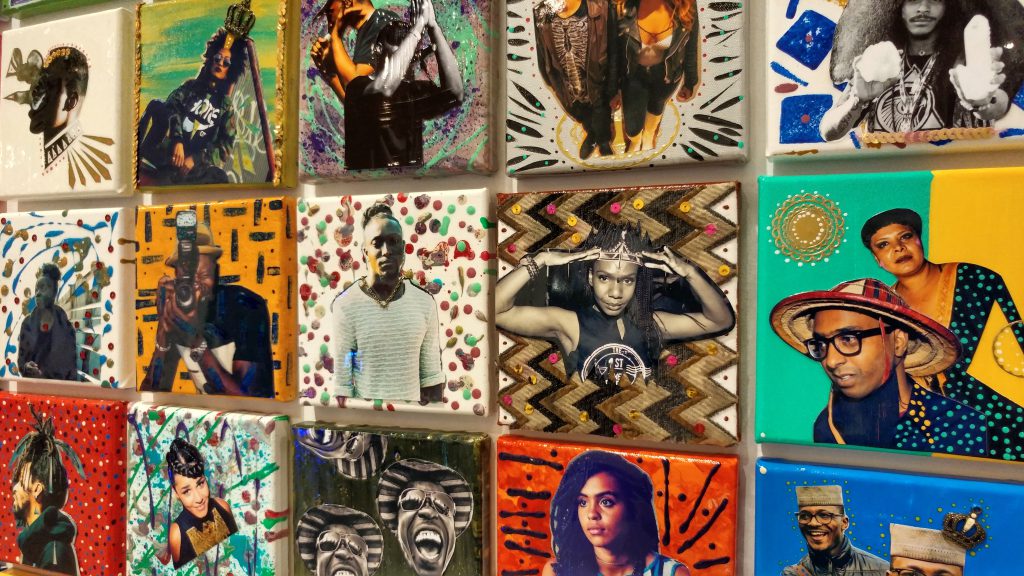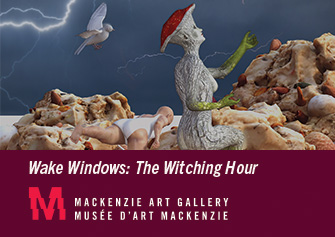the royalty’s inherent
3 October 2017
By Olivia Wallace
Stepping into Daniels Spectrum is not your everyday gallery visit. Daniels Spectrum is the cultural hub for Toronto’s Regent Park—a neighbourhood of individuals from a wide range of socioeconomic and racial backgrounds. The Invisible Majority, displayed in the Hallway Galleries of Daniels Spectrum, is Zahra Siddiqui’s first solo exhibition. The artist is a Torontonian of South Asian descent whose photography practice has centered on people of colour from Toronto, the Caribbean and the US. Her portraits, as described in the gallery write-up, “[demand] our respect and reverence for her subjects” and “[connect] us to the actual composition of this multicultural metropolis”. (1) Considering Siddiqui’s usual practice, I anticipated an unparalleled perspective in portrait photography. Her kaleidoscope of remixed photographs delivered that and much more.
The first piece I encountered was The Grid (2016)—an installation composed of over one hundred 6 x 6” canvases. Each canvas presented portraits of individuals from the Toronto arts community. I recognized some of Toronto’s well-known hip-hop artists, fashion icons, visual artists and spoken word poets. More interestingly, the subjects in Siddiqui’s work are all people of colour, and combined with the multitude of materials used—acrylic paint, photography, textiles, sequins and beads—the work “is a celebration of her diverse roots and heritage”. (2)
Initially I found myself mesmerized by the array of brightly coloured canvases and charismatic portraits. Yet after a closer inspection of the individual pieces, I was surprised to have overlooked text imbedded within the elaborate compositions. Using newspaper clippings and lines of poetry, Siddiqui incorporates references to racial discrimination that is far too familiar to Toronto’s Black community. One canvas in particular, which featured the back of a Black man’s head on top of brightly painted colours, had words arranged over and around it, as though his body and mind were encompassed by the poetic expressions of his personal trials, and the obligation he feels to conceal his sorrows. It’s impossible for me to read these expressions of an oppressed spirit and not think about police brutality against Black men and even Black young boys in Western society. Rather than painting away the unfortunate reality of racism, the work mindfully incorporates the everyday battle faced by people of colour.

The narrative and compositional choices truly resonate with me. As an artist particularly interested in mixed media practices and a person of colour who admires the individuals portrayed, I am elated yet unsettled by the work. I delight in reflecting on the achievements of the icons depicted in Siddiqui’s vibrant pieces (hip-hop artists to fashion icons); however I also sense grief and hardship, like an underlying current in the turbulent waves of the subjects’ beautiful existence.
With the perpetual emphasis on Toronto’s ethnic diversity, obstacles specific to the people of colour who live here are often overlooked. Yet artists who are also curators and social activists, such as Anique Jordan and Deanna Bowen, have dedicated themselves to not only exposing racial discrimination, but generating meaningful dialogue through art. Their exhibitions, such as Every. Now. Then: Reframing Nationhood at the Art Gallery of Ontario and most recently Deanna Bowen: On Trial The Long Doorway at Mercer Union, make room for the stories of people of colour to be expressed and acknowledged.
The Invisible Majority not only emphasizes the visibility of people of colour, but elicits reflection, understanding and builds solidarity amongst audience members in a subtle public protest. Working in this way, the show echoes the practices of artists such as African American artist Wadsworth Jarrell.

He used portraiture, text and colourful patterning in his paintings to voice his perspective on life for Black men and women during the Civil Rights era of the 1950’s to 1970’s. In one of his pieces titled, “Three Queens” (1971), recently acquired by the Detroit Institute of Arts, words of self-love encircle the faces of three Black women. The Invisible Majority effectively employs similar artistic tools, mobilizing a message for the public and honouring the contemporary Black experience.
The show also featured a series of seven 30 x 30” paintings called Baadshah & Malka (2016), which is “King and Queen”, in Urdu. These paintings continued the aesthetics of The Grid, but expanded into larger royal portraits. In these works Siddiqui’s abstract painting methods of bold acrylic backgrounds filled with swirls, dots and embellishments take on a grander scale, allowing the subjects to be pondered individually, rather than as a whole. What I find most interesting about some of the subjects is that they aren’t assuming a particular pose that would be considered “royal” from a Western art historical perspective, yet the artist refers to them as such. In one piece a woman is looking down at her phone, and in another the subject’s face is covered by the lens of their camera. Calling Black women “queens” during the 1960’s and 70’s, “was understood in African American communities as an expression of respect or endearment for women of African descent”. (3) This use of “queen” is also common in the Caribbean. Here, Siddiqui continues this tradition through her titling and use of crown iconography throughout the exhibition. By simply existing, these men and women are inherently royal.
As her first solo exhibition, The Invisible Majority is a brilliant beginning to Siddiqui’s career as an exhibiting artist. Siddiqui, along with curators elle alconcel and Negarra Kudumu, have created a poignant show that successfully celebrates the artist’s peers, while sharing a greater message with the city of Toronto. Although The Invisible Majority can’t make up for the years I longed to see people who looked like me represented in a respectful way in the media, the show recognizes and addresses this lack in a satisfying way. The Invisible Majority is a relevant catalyst that stimulates important conversations about race, diversity, and “royalty”. This show began in the right place, at the right time, and I believe there should be no limit to its visibility.
- http://danielsspectrum.ca/event/the-invisible-majority-1st-solo-exhibition-by-zahra-siddiqui-opening-reception/
- Ibid.
- Mercer, Valerie J. Art of Rebellion: Black Art of the Civil Rights Movement. Detroit, MI, Detroit Institute of Arts, 2017.
The exhibition The Invisible Majority took place at Daniel’s Spectrum Hallway Galleries in Toronto, ON from September 8 – October 31, 2016.
Feature image courtesy of Olivia Wallace.



